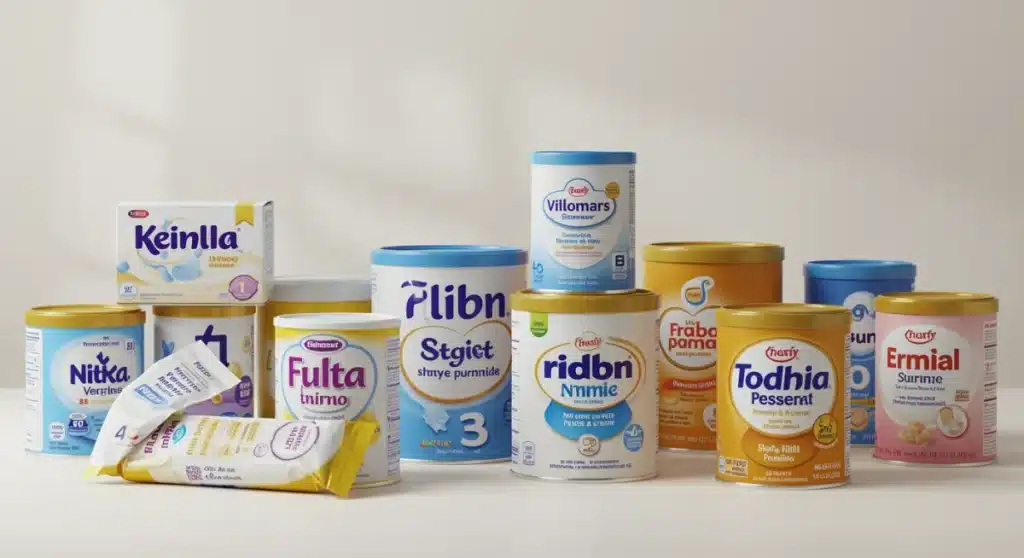Choosing the Right Baby Formula: Top Brands Compared for 2025

Advertisement
Understanding the nuances of nutritional content, ingredient sourcing, and brand reputation is paramount for parents when selecting the most appropriate baby formula to support their infant’s growth and well-being.
When embarking on the incredible journey of parenthood, few decisions feel as weighty as ensuring your little one receives the best possible nutrition. For many families, this means navigating the intricate world of baby formulas. Making an informed choice about choosing the right baby formula: a comprehensive comparison of top brands in 2025 is not just about picking a product off the shelf; it’s about understanding the science, the ingredients, and the specific needs of your growing infant. This guide aims to simplify that process, empowering you with the knowledge to select a formula that supports your baby’s health and development.
Advertisement
Understanding Baby Formula Basics: What’s Inside?
Before diving into specific brands, it’s crucial to grasp the fundamental components of baby formula. These products are meticulously designed to mimic breast milk as closely as possible, providing a balanced diet for infants who are not breastfed or are partially breastfed. The core ingredients are regulated to ensure they meet stringent nutritional standards.
Formulas typically contain a blend of carbohydrates, proteins, fats, vitamins, and minerals. Each of these plays a vital role in your baby’s development, from brain growth to bone strength. Understanding the source and type of these macronutrients and micronutrients can help parents identify formulas that align with their baby’s unique requirements or sensitivities.
Key Nutritional Components
- Carbohydrates: Primarily lactose, the natural sugar found in milk, provides energy. Some specialty formulas use corn syrup solids or maltodextrin for lactose-sensitive infants.
- Proteins: Derived from cow’s milk, soy, or hydrolyzed proteins. Cow’s milk protein is the most common, while hydrolyzed formulas break down proteins for easier digestion in sensitive babies.
- Fats: Essential for brain and eye development, often from vegetable oils like palm, soy, coconut, or sunflower oil. DHA and ARA are crucial fatty acids often added for cognitive and visual development.
- Vitamins & Minerals: A comprehensive array including iron, vitamin D, calcium, and zinc, all critical for growth and immunity.
The careful balance of these ingredients is what makes baby formula a complete nutritional source. Manufacturers continuously refine their formulations based on the latest scientific research and pediatric recommendations, ensuring that babies receive everything they need for healthy growth.
Advertisement
Decoding Formula Types: Standard, Organic, & Specialty
The baby formula market is remarkably diverse, offering various types designed to cater to different needs and preferences. Beyond the basic nutritional profile, parents often encounter distinctions such as standard, organic, and a range of specialty formulas. Each category comes with its own set of considerations, from ingredient sourcing to specific dietary adjustments.
Understanding these classifications is key to making an informed choice. It’s not just about what’s in the formula, but also how those ingredients are produced and for whom the formula is best suited. This section will break down the primary types you’ll encounter, helping you narrow down the options.
Standard Cow’s Milk-Based Formulas
These are the most common and widely available formulas. They use cow’s milk protein as their base, which is modified to be more digestible for infants. They are fortified with iron and other essential nutrients to support healthy growth and development. Most healthy, full-term infants thrive on standard cow’s milk-based formulas.
For instance, brands like Enfamil and Similac offer extensive lines of cow’s milk-based formulas, each with slight variations in their carbohydrate and fat blends. They are often the first choice for parents unless a specific intolerance or allergy is identified.
Organic Baby Formulas
Organic formulas adhere to strict organic farming standards, meaning the milk used comes from cows not treated with hormones or antibiotics, and the crops used for other ingredients are grown without synthetic pesticides or fertilizers. While the nutritional profiles are generally similar to standard formulas, parents often choose organic options for perceived benefits related to purity and environmental impact.
However, it’s important to note that ‘organic’ doesn’t necessarily mean ‘better’ nutritionally than conventional formulas, as all formulas must meet the same FDA nutritional requirements. The choice often comes down to personal values and preferences regarding agricultural practices.
Specialty Formulas for Unique Needs
- Hypoallergenic/Hydrolyzed Formulas: Proteins are broken down into smaller pieces, making them easier to digest for babies with cow’s milk protein allergy or severe sensitivities. Examples include Alimentum and Nutramigen.
- Soy-Based Formulas: An option for infants with cow’s milk protein allergy or lactose intolerance, though often not recommended as a first choice for allergy due to potential cross-reactivity.
- Lactose-Free Formulas: Designed for babies with lactose intolerance, where the lactose is removed or replaced with other sugars.
- Anti-Reflux (AR) Formulas: Thicker than standard formulas to help reduce spit-up, often containing rice starch.
- Preterm Formulas: Higher in calories, protein, and certain vitamins and minerals to support the rapid growth of premature infants.
These specialized formulas are typically recommended by pediatricians based on a baby’s specific health concerns. It is always best to consult with a healthcare professional before switching to a specialty formula.

Choosing the correct formula type is a collaborative decision between parents and their pediatrician. Factors such as allergies, digestive issues, and overall health status play a significant role in determining the most suitable option for your baby’s optimal development.
Leading Brands in 2025: A Detailed Look
The baby formula market is dominated by several well-established brands, each with a long history of providing infant nutrition. In 2025, these brands continue to innovate, offering a wide array of products to meet the diverse needs of infants. This section will delve into some of the top brands, highlighting their key offerings, unique selling points, and what makes them stand out in a competitive landscape.
Understanding the specifics of each brand can help parents make a more informed decision, aligning their choice with their baby’s health requirements and their family’s values. From ingredient sourcing to specialized formulations, each brand brings something different to the table.
Enfamil: A Legacy of Innovation
Enfamil, produced by Reckitt Benckiser, is one of the most recognized names in infant nutrition. They are known for their strong emphasis on scientific research and development, often being among the first to incorporate new nutritional advancements, such as DHA and ARA, into their formulas. Their product line is extensive, catering to various stages of development and specific dietary needs.
- Enfamil NeuroPro: Their flagship product, featuring a fat-protein blend of MFGM (Milk Fat Globule Membrane) and DHA, which they claim supports brain development similar to breast milk.
- Enfamil Gentlease:0 Designed for fussiness, gas, and crying, with partially hydrolyzed proteins for easier digestion.
- Enfamil A.R.: A thickened formula to reduce spit-up, containing added rice starch.
- Enfamil Nutramigen: A hypoallergenic formula for babies with cow’s milk protein allergy.
Enfamil’s commitment to research and a broad product range makes it a popular choice for many parents and pediatricians alike. They consistently aim to provide formulations that support comprehensive infant development.
Similac: Dedicated to Science-Backed Nutrition
Abbott’s Similac is another powerhouse in the baby formula world, often seen as a direct competitor to Enfamil. Similac also boasts a strong scientific foundation, focusing on ingredients that support immune function and brain development. Their formulas are widely available and come in a variety of preparations, including powder, ready-to-feed, and concentrate.
- Similac 360 Total Care: Features a blend of 5 HMOs (Human Milk Oligosaccharides) found in breast milk, designed to support immune health, brain development, and digestion.
- Similac Alimentum: A hypoallergenic formula for severe food allergies, with extensively hydrolyzed proteins.
- Similac Pro-Advance: Designed for immune support, with 2′-FL HMO.
- Similac Organic: Certified organic option for parents preferring organic ingredients.
Similac’s extensive research into HMOs has positioned them as a leader in immune-supporting formulas, offering parents diverse options tailored to varying infant needs and sensitivities.
Gerber Good Start: Gentle Nutrition Focus
Gerber, a well-known name in baby food, also offers a line of baby formulas under the Gerber Good Start brand. Their formulas often emphasize a ‘gentle’ approach, with many products featuring comfort proteins that are partially hydrolyzed to be easier on a baby’s digestive system. They aim to provide complete nutrition while minimizing common feeding issues.
Their product range includes options for everyday feeding, sensitive tummies, and organic choices. Gerber Good Start often appeals to parents looking for a balance of comprehensive nutrition and digestive comfort for their infants.
Other Notable Brands
- Earth’s Best Organic: Focuses exclusively on organic formulas, often praised for their simple ingredient lists and commitment to organic standards. Offers dairy and sensitivity options.
- Happy Baby Organic: Another organic brand known for its commitment to high-quality ingredients and a range of organic options, including those with prebiotics.
- Kendamil: A UK-based brand gaining popularity in the US, known for its whole milk-based formulas and absence of palm oil, fish oil, and soy. Offers both organic and classic lines.
The landscape of baby formula is dynamic, with ongoing research leading to new developments. Each of these brands strives to meet the nutritional needs of infants while offering choices that align with parental preferences, whether that’s organic certification, specific protein structures, or unique ingredient blends.
Key Factors in Your Decision: Ingredients, Allergies, and Digestion
Selecting the right baby formula goes beyond just brand recognition; it involves a deep dive into specific factors that directly impact your baby’s health and comfort. The ingredients list, potential allergens, and how easily a formula is digested are paramount considerations. These elements dictate whether a formula will be a good fit for your infant’s unique physiological makeup.
Understanding these critical aspects can help parents avoid common feeding issues and ensure their baby receives optimal nutrition without discomfort. It’s about being proactive and informed, rather than reactive to problems that might arise.
Ingredient Scrutiny: What to Look For
The ingredient list on a formula can seem daunting, but focusing on a few key areas can simplify the process. Look for formulas that are fortified with iron, as this is crucial for preventing iron-deficiency anemia in infants. The presence of DHA (docosahexaenoic acid) and ARA (arachidonic acid) is also highly recommended, as these fatty acids are vital for brain and eye development, mirroring their presence in breast milk.
Parents might also consider the type of carbohydrate used. Lactose is preferred as it is the primary carbohydrate in breast milk. However, for lactose-sensitive babies, alternatives like corn syrup solids or maltodextrin might be present in specialty formulas. Additionally, some parents prefer formulas without palm oil due to concerns about its impact on calcium absorption, though this remains a debated topic among experts.
Addressing Allergies and Sensitivities
Food allergies and sensitivities are a significant concern for many parents. Cow’s milk protein allergy (CMPA) is one of the most common, manifesting as symptoms like excessive crying, gas, vomiting, skin rashes, or blood in the stool. For babies with suspected CMPA, a pediatrician will typically recommend extensively hydrolyzed formulas, where the proteins are broken down into very small peptides, making them less likely to trigger an allergic reaction.
Lactose intolerance, while less common in infants than CMPA, also requires specific formula adjustments. Lactose-free formulas replace lactose with other sugars, alleviating digestive discomfort. It’s crucial to consult a pediatrician if you suspect your baby has an allergy or sensitivity, as they can accurately diagnose the issue and recommend the appropriate formula.
Digestive Comfort and Issues
- Gas and Fussiness: Many formulas are designed to be ‘gentle’ with partially hydrolyzed proteins, which can be easier to digest and reduce gas and fussiness.
- Reflux/Spit-Up: For babies experiencing frequent spit-up, anti-reflux (AR) formulas are thickened with rice starch or other ingredients to help keep the formula down.
- Constipation: Some babies may experience constipation on certain formulas. Ensuring adequate hydration and sometimes switching to a different formula type (e.g., one with prebiotics) can help.
Monitoring your baby’s reaction to formula is essential. Changes in stool consistency, frequency of spit-up, or levels of fussiness can all indicate whether a particular formula is agreeing with your baby. Open communication with your pediatrician is vital for addressing any digestive issues effectively.
Navigating Regulations and Safety Standards
The safety and nutritional adequacy of baby formula are paramount, and regulatory bodies play a crucial role in ensuring these standards are met. In the United States, the Food and Drug Administration (FDA) meticulously regulates infant formula, setting strict requirements for nutrient content, manufacturing practices, and labeling. This oversight provides a layer of assurance for parents, knowing that the formulas available on the market have undergone rigorous scrutiny.
Understanding these regulations and the safety measures in place can build confidence in your choice. It’s not just about what’s on the label, but the extensive process behind getting that product into your hands.
FDA Regulations in the United States
The Infant Formula Act of 1980, amended in 1986, gives the FDA authority over infant formula. This act mandates that all infant formulas sold in the U.S. meet specific nutrient requirements, including minimum and, in some cases, maximum levels for 29 nutrients. Manufacturers must also adhere to good manufacturing practices (GMPs) to ensure the safety and quality of their products. This includes regular testing of ingredients and finished products for contaminants and nutritional content.
- Nutrient Requirements: Strict guidelines for levels of protein, fats, carbohydrates, vitamins, and minerals.
- Quality Control: Manufacturers must test each batch for nutrient content and safety.
- Labeling Standards: Clear and accurate labeling of ingredients and nutritional information is required.
The FDA’s role is to ensure that infant formulas are safe and nutritionally complete, providing a reliable sole source of nutrition for infants up to 12 months of age. This regulatory framework is a cornerstone of infant formula safety.
International Standards and Import Considerations
While U.S. parents primarily rely on FDA-regulated formulas, some may consider imported formulas. It’s important to understand that international formulas, while regulated by their respective countries’ authorities (e.g., European Food Safety Authority – EFSA), do not automatically meet all FDA requirements. For example, some European formulas may have different nutrient levels or ingredient restrictions compared to those mandated by the FDA.
Imported formulas are not subject to the same FDA oversight as those manufactured and sold within the U.S. Parents should exercise caution and conduct thorough research if considering imported options, ideally discussing it with their pediatrician to ensure nutritional adequacy and safety. The safety and quality of formula are always highest when sourced through regulated channels.
Ensuring Product Safety and Quality
Beyond regulatory compliance, reputable formula manufacturers implement their own stringent quality control measures. This includes sourcing high-quality ingredients, maintaining sterile manufacturing environments, and conducting extensive testing throughout the production process. Parents can often find information about these practices on brand websites or by contacting customer service.
Recalls, though rare, can occur. Staying informed about product recalls through official channels like the FDA website or trusted news sources is a good practice. Ultimately, choosing a formula from a well-established brand with a strong track record of safety and adherence to regulatory standards is key to ensuring your baby’s well-being.
The Cost Factor: Budgeting for Baby Formula
For many families, the cost of baby formula is a significant consideration. Formula feeding can be expensive, and understanding the financial implications is an important part of the decision-making process. Prices can vary widely based on brand, type (standard vs. organic vs. specialty), and format (powder, concentrate, ready-to-feed). Budgeting effectively means not only looking at the upfront cost but also considering the long-term expenses.
While cost should never compromise your baby’s nutritional needs, there are smart ways to approach purchasing formula without breaking the bank. Informed choices can lead to substantial savings over the course of your baby’s first year.
Comparing Costs Across Brands and Types
Generally, store-brand or generic formulas are less expensive than name-brand options. They are often manufactured by the same companies as the name brands and are required to meet the same FDA nutritional standards, offering a nutritionally equivalent product at a lower price point. Organic formulas typically command a higher price due to the increased cost of organic ingredients and certification processes.
Specialty formulas, such as hypoallergenic or anti-reflux varieties, are almost always the most expensive due to their specialized ingredients and manufacturing processes. These formulas are often medically necessary, making their higher cost unavoidable for some families.
Powder, Concentrate, or Ready-to-Feed?
- Powdered Formula: This is generally the most cost-effective option. It requires mixing with water, offering the most servings per container.
- Liquid Concentrate: A mid-range option, requiring dilution with water. It’s more convenient than powder but more expensive.
- Ready-to-Feed: The most convenient and hygienic option, as it requires no mixing. However, it is also the most expensive per ounce, often reserved for travel or specific situations.
Choosing the format that best fits your lifestyle and budget can significantly impact overall costs. Many parents opt for powdered formula for daily use and keep some ready-to-feed for emergencies or outings.
Saving Money on Formula
There are several strategies parents can employ to reduce the cost of formula:
- Coupons and Rebates: Sign up for mailing lists from formula brands to receive coupons and special offers.
- Bulk Purchases: Buying larger containers of powdered formula often results in a lower cost per ounce.
- Store Brands: Consider store-brand formulas, which are nutritionally comparable to name brands but more affordable.
- WIC Program: For eligible families, the WIC (Women, Infants, and Children) program provides financial assistance for formula purchases.
- Doctor Samples: Pediatricians often have samples of various formulas, which can be helpful for trying different types before committing to a large purchase.
While cost is a factor, it’s essential to prioritize your baby’s health and consult with your pediatrician before making any formula changes based solely on price. Finding the right balance between affordability and nutritional needs is key to successful formula feeding.
Making the Best Choice for Your Baby’s Future
Ultimately, the decision of which baby formula to choose is a deeply personal one, influenced by a myriad of factors unique to your family and, most importantly, your baby. There is no one-size-fits-all answer, and what works wonderfully for one infant might not be suitable for another. The journey involves careful consideration, informed research, and often, collaboration with healthcare professionals.
Empowering yourself with knowledge about ingredients, brand offerings, and safety standards is the first step. The goal is to provide your baby with the best possible nutritional foundation for healthy growth and development.
Consulting Your Pediatrician
Perhaps the most crucial piece of advice is to always consult your pediatrician. They possess the medical expertise to assess your baby’s specific health needs, identify any potential allergies or sensitivities, and recommend formulas that are best suited for their individual development. Your pediatrician can provide personalized guidance, helping you navigate the complexities of formula selection and ensuring your baby thrives.
Before making any significant changes to your baby’s feeding regimen, including switching formulas, a discussion with your doctor is highly recommended. They can offer insights into how different formulas might impact your baby’s digestion and overall well-being.
Observing Your Baby’s Reaction
Once you’ve chosen a formula, closely observing your baby’s reaction is vital. Look for signs of good digestion, such as regular bowel movements, minimal gas, and a generally comfortable demeanor after feeding. Conversely, watch for signs of discomfort, like excessive crying, fussiness, frequent spit-up, or skin rashes, which could indicate that the formula isn’t agreeing with them.
It may take a few days for your baby to adjust to a new formula, but persistent issues warrant a conversation with your pediatrician. Sometimes, a simple switch to a different type of formula can make a world of difference in your baby’s comfort and happiness.
Trusting Your Parental Instincts
Beyond all the research and medical advice, remember to trust your parental instincts. You know your baby best, and your observations are invaluable. While scientific information is crucial, the comfort and well-being of your child are the ultimate indicators of whether a particular formula is the right fit. This comprehensive comparison of top brands in 2025 aims to equip you with the tools to make an educated decision, but the final choice rests with you, the loving parent.
Choosing the right baby formula: a comprehensive comparison of top brands in 2025 is a significant step in your parenting journey. By combining knowledge with careful observation and professional guidance, you can confidently select a formula that nourishes your baby and supports their bright future.
| Key Aspect | Brief Description |
|---|---|
| Nutritional Content | Formulas are designed to mimic breast milk, providing essential carbs, proteins, fats, vitamins, and minerals for infant development. |
| Formula Types | Includes standard cow’s milk, organic, hypoallergenic, soy-based, and anti-reflux options to meet diverse infant needs. |
| Top Brands | Leading brands like Enfamil, Similac, and Gerber Good Start offer scientifically backed formulations catering to various infant requirements. |
| FDA Regulation | All U.S. infant formulas are strictly regulated by the FDA, ensuring safety, nutrient content, and manufacturing quality. |
Frequently Asked Questions About Baby Formula
If your baby exhibits persistent symptoms like excessive gas, fussiness, frequent spit-up, skin rashes, or blood in their stool, they might need a special formula. Always consult your pediatrician for a proper diagnosis and recommendation before making any changes.
While organic formulas adhere to specific farming standards (no synthetic pesticides, hormones, or antibiotics), all formulas, organic or conventional, must meet the same strict FDA nutritional requirements. Nutritional superiority is not guaranteed by organic status alone.
Powdered is the most economical, requiring mixing with water. Liquid concentrate also needs water but is more convenient. Ready-to-feed is pre-mixed and most convenient, but also the most expensive option, often used for travel or emergencies.
You should consider switching formula if your baby shows consistent signs of discomfort, allergies, or digestive issues that are not resolving. Any decision to switch should always be made in consultation with your pediatrician, who can guide you to the most appropriate alternative.
It is generally not recommended to mix different brands or types of formula unless specifically advised by a pediatrician. Mixing can alter the nutritional balance or cause digestive upset. Stick to one type of formula at a time for consistency and safety.
Conclusion
The journey of choosing the right baby formula: a comprehensive comparison of top brands in 2025 is a critical one for new parents, impacting their baby’s health and development. By understanding the core nutritional components, distinguishing between standard, organic, and specialty formulas, and delving into the offerings of leading brands like Enfamil, Similac, and Gerber Good Start, parents can make informed decisions. Key factors such as ingredient scrutiny, addressing allergies and sensitivities, and ensuring digestive comfort are paramount. Furthermore, being aware of stringent FDA regulations and budgeting wisely for formula purchases contributes to a confident choice. Ultimately, the best formula is one that supports your baby’s unique needs, enhances their well-being, and aligns with your family’s informed preferences, always in consultation with your pediatrician.





